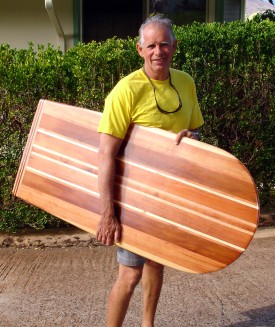April 9, 2010. Honolulu, Hawai`i
e-Mail interview based on questions by Bob Green
Interview organized by John Clark
Photographs courtesy of Bud Scelsa and others as noted
1. When and where did you begin surfing?
When did you first ride a paipo board?
I
began as a kid growing up in the 1940s, 50s and 60s in Newport Beach,
California. (I graduated high school in 1964). I think the first board
I noticed was one my uncle Don Donaldson built in the late 1930s, in
the wood shop at Newport Harbor High. The board was a Tom Blake style
hollow plywood board about 12 foot long. I had two brothers and we’d
drag it around the yard pretending to surf. I think we had the board
taken to the water for us only a few times. The board disappeared
sometime in the 1960s.
As
grade school kids we had air mats, and we body surfed places like the
Wedge, Corona del Mar, and the Newport Pier. During high school years
we’d drive up and down the West Coast as far north as Half Moon Bay and
south into Northern Baja Mexico with our surfboards.
By
1960, board surfing was exploding in popularity in Orange County. As
typical kids we begged our dad to get us surfboards. We had no more
than two boards between the three of us. Using the formulas for size at
the time, I think they were between 9’2” and 9’6”. All the famous
builders we know today were making boards in and around Orange County.
Our boards were a Velzy and a Weber. Later on my brother Greg got a
Gordon & Smith pin tail.
We all wished for a Joe Quigg board but
never got the money together. The way
we’d deal with the Quigg problem
was to ride our bikes down to his shop near the cannery and hang around
while his shaper, Moyer, worked.
|
Bud holding a board made of redwood and
pine, 52" long, 24" wide nose, and
a 21 1/2" tailblock (Sept. 2007)
Photo by Kai Lyons
|
During
this time I crossed-over a lot between surf styles. I was board surfing
as much as possible in high school but it was hard to carry a board
under my arm riding a bike up and down the hill between Newport Heights
and 32nd Street. At the same time I was becoming a body surfing regular
at the Wedge, as well as trying to build “belly boards.” The belly
boards were about 4'6" feet and shaped like a small Malibu style board
with a laminated wood fin. I was able to make these for very little
since I’d get scrap blanks from Clark Foam and then do the shaping and
glassing at my uncle’s custom boat building yard nearby (Dittmar &
Donaldson). I am still looking for the only picture I have of that time
with me and a board stuck in the sand at the Wedge. The swim fins I
used then and for the next 20 years were brown UDT Duck Feet.
The
first time I rode a paipo was about 1966, at Makapu`u and Sandy Beach.
I was in the USCG and just passing through on a ship from LA to Japan.
I hitch hiked out to Sandy Beach and Makapu`u with my fins to surf the
motherland. I met some locals who were more than happy to let me give
it a try. In the beginning I was riding prone on a homemade plywood
board shaped like a hyperbolic curve. I have forgotten the names,
unfortunately, of the locals.
2.
What do you recall about paipo or bellyboards at Newport?
The
belly board scene was tough. The board surfers didn’t want to be near
you, nor did the body surfers at the Wedge. Since I was a Wedge
bodysurfing regular, I got some slack sometimes, but that place was too
dangerous for mixed surf tools. The Wedge was too dangerous for any
kind of imperfect style. For example, one morning it was breaking about
6-8 ft and a few of us were out. Joe Quigg and his buddy Carter Pyle
got in and started going at it. After a few waves another regular, a
big guy named Terry, took off on Joe on a fairly big wave. Joe went
over the falls and landed on his shoulder, which twisted his back.
Carter had to help him out of the water. Joe Quigg was never the same.
He seems to always be in back pain.
3.
When did you leave Newport for Hawai`i?
I
enlisted in the US Coast Guard in 1966. After a few months, a shipmate
got orders for Hawai`i, so I put in a request to take his place, since
we had the same job anyway. (I think they called that a sea-going
janitor.) When I arrived in Honolulu by plane in May 1968, I was
picked-up by a friend I had met a few years earlier in California,
Auwae Noa Kepoikai Lyons Jr. Noa was a yacht sailor I’d met in Newport.
We’d bodysurfed the Wedge together many times until I enlisted. Noa
went back to Hawai`i shortly after that, since his gig on the yacht was
up.
Noa’s
family was incredibly kind to me. Without asking me, they had prepared
a room for me at their house up on Wilhelmina Rise. I went from the
airport to my new home. Noa’s father was Auwae Noa “Kepoikai” Lyons, or
“Splash.” Splash was one of the first beach boys on Waikiki Beach. He
had come from Maui in the early 1920s to attend Kamehameha Schools.
Splash was also a professional musician.
Splash
worked with Panama Dave, Chick Daniels, Turkey Love… all the regulars
at the beach. Of course Splash and Duke Kahanamoku were close friends.
They even took a trip together to New York City in the early 1930s. I
have a diary of the trip as well as a picture of this group of
Hawai`ians standing at the top of the Empire State building in winter
coats. I was always impressed to see Duke’s phone number in Splash’s
phone booklet as well as all the photos of them together around the
house.
4.
When you first arrived in Hawai`i where were paipo being ridden? Any
paipo riders from that time stand out?
Paipo
were commonly ridden in the mid-1960s at all the good surf spots. All
of them were plywood boards, either painted or even bare. The more
common places to ride paipo were Makapu`u, Sandy Beach, and Point Panic
in town. No boards with fins were allowed at these spots. I was not too
conscious of who was riding where around the island.
5.
When did you get into riding paipo on your knees? Who or what
influenced your approach to riding paipo in this way?
John
Wilkie, one of my friends, had a board I’d made. John was a knee rider
and body surfer. In the earlier days I made two-piece boards of either
cedar or redwood, glued them with Resorcinol, then glassed them with
6-ounce e-glass and polyester.
I was still riding prone, but one day
John took me out to a place called Erma’s, near Sandy Beach, and
encouraged me to go “knee-down.” That was probably 1968 or 1969, and
that’s the way I’ve been riding ever since.
These
are examples of Bud's original boards that were made out of two 12"
redwood planks. The board in the middle broke in half, which is why
there's a crack visible in the nose. The yellow and black material was
an experiment in deck padding, which didn't work. ca. 1974
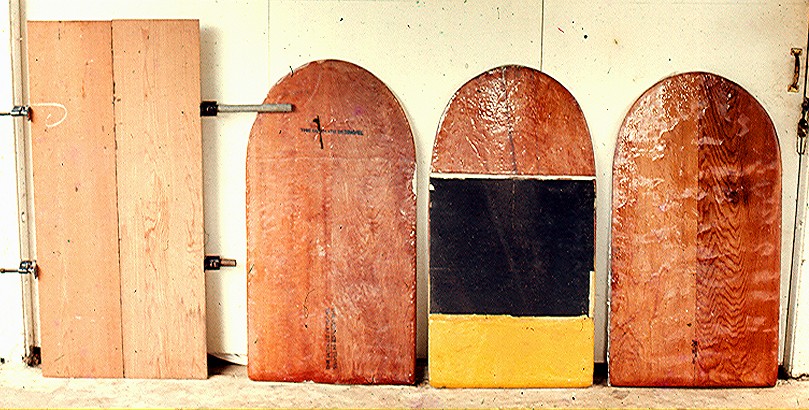
Photo courtesy of Bud Scelsa.
Bud riding his paipo “knee-down” style at
Makapu`u, ca. 1969
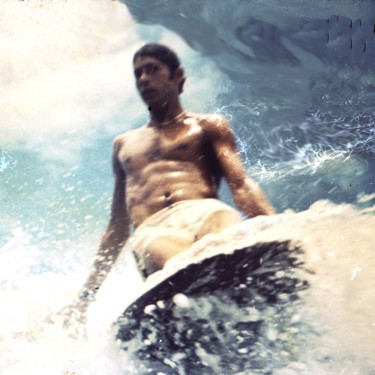
Photo by Lt. N. Scarborough, who was in the Coast Guard with Bud.
6.
How do the boards required to knee ride a paipo differ from a paipo
board ridden prone?
I
think the big difference is when riding knee-down, all of your weight
is on the board, and the trim point is dictated by the weight. Kinda
like a water ski. When the waves are small, it is not possible to get
up on my knees without causing the board to bog down and lose the wave.
This happens in about two foot or so surf, depending on how steep the
wave is. Small waves can easily be ridden prone because of the change
of trim and the longer waterline added by your legs and fins. For me
riding knee-down is more fun because I see the wave from a little
higher position and no spray is thrown in my face, a big problem on big
days, especially on the drop.
7.
How is the riding a paipo knee style different to riding prone?
Prone
riding seems to favor more of a straight, down the line style.
Knee-down allows for more turning and cut-back manoeuvres. With
knee-down it seems to be easier to find the perfect part of the wave
without over-shooting the active part of the shoulder due to the high
speed.
8.
How many paipo boards do you estimate that you have made over the
years?
I
guess I’ve made at least 30 boards over the years. I wish I knew where
they all went… although I do still have two of the early two-piece
style.
Six paipo boards (2006)
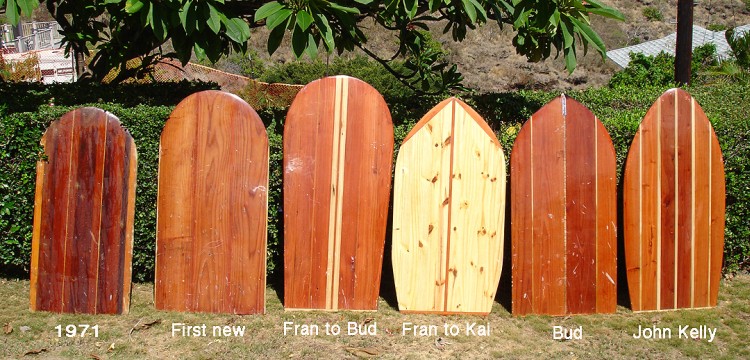
From left to right: 1. 1971. This is one of Bud's oldest boards. It's redwood and cedar. 2. First new. This was the first new board Bud made when he moved from Maui back to Oahu in 2005. 3. Fran to Bud.
Bud made this board in honor of his friend legendary surfer Fran Heath.
Fran had a solid redwood hot curl board with double pine stringers, so
Bud duplicated the look in this paipo board and had Fran sign it. 4. Fran to Kai. Bud made this board out of notty pine and redwood for his nephew, Kai Lyons, and had Fran Heath sign it to Kai. 5. Bud. A redwood and pine board that Bud made for himself. 6. John Kelly.
Bud made this board in honor of his friend, legendary surfer John
Kelly, who designed the first hot curl board. Bud pulled in the nose of
this paipo board to duplicate the look of John's board and to make the
board ride better in steeper sections.
These are the same boards shown in the group photo above, plus one, and a new unglassed board on the far right. Shot on location at the Waialua Sugar Mill on the North Shore (July 2007).
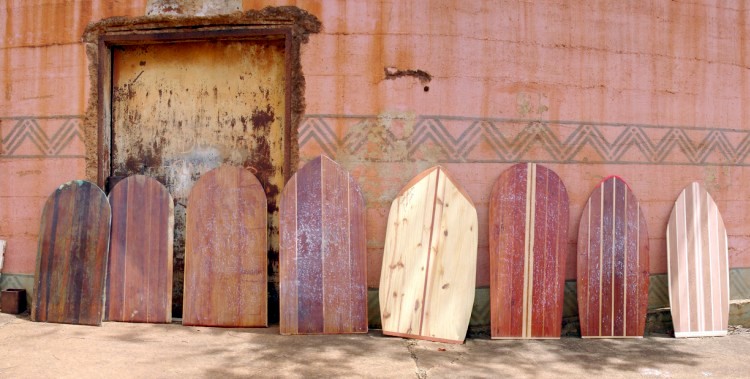
Photo by Cher Pendarvis.
9.
Have you also made fibreglass boards or do you only make wooden boards?
I
made a foam belly board with a laminated wood skeg when I was in
California. That board was ridden at the Wedge and other spots around
Newport Beach. In Hawai`i, I’ve only made wooden boards.
10.
What woods do you use in your boards?
I
made my old two-piece boards by laminating two 12-inch wide, 3/4”
redwood planks together, cutting a round nose with a square tail, and
then glassing them with single 6 oz cloth. Those boards were heavy
compared to some of the later ones because I only ground the shape and
thickness with a grinder down to about ¾” or 5/8”, whereas the boards
I’ve made in the last 10 years have been thinned with a planer down to
about 1/2 inch.
The
boards I’ve made since 2004 have taken on a totally different look and
feel for a variety reasons. Each one is different due to the wood
sources and the end-user. I look for used redwood, mahoganies, spruce
masts, old pianos, as well as very old fir from tear downs. Recently, I
was fortunate enough to get some native wiliwili, via Ian Masterson and
John Clark, that I laminated with koa stringers. The koa was purchased.
My newer boards usually have at least 20 pieces of wood.
John Clark wanted to get the feel of riding prone on a traditional Hawaiian
board, so he designed these two boards and asked Bud to make them. Both of these paipo boards are alaia shapes,
5' 2" long, 3/8" thick, flat-bottomed, and do not have fins. The board
on the left is redwood with pine stringers. The board on the right is
all native wood, wiliwili, which is like a Hawaiian balsa, with koa
stringers. Standing next to the boards is John Clark, at Publics, in
Waikiki.
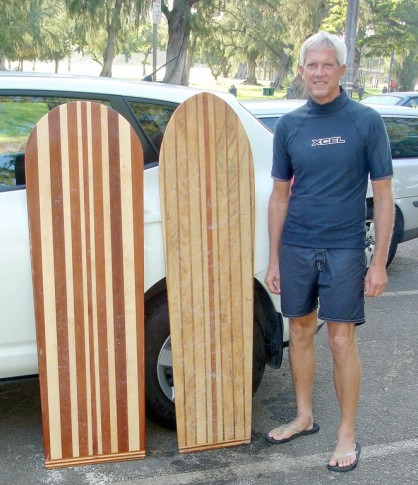
Photo by Bud Scelsa.
11.
What are the design features and dimensions of a typical board that you
would make?
The
basics are simple. If it’s fits under my arm and will fit sideways in
the back of my car, it’s perfect! As silly as its sounds, that’s about
it. Some time ago, George Downing sketched a rail shape for me to try,
and I softened the straight rails to a more tapered shape, making the
wide spot about mid-board. Those boards have ridden and manoeuvred
better than any I made before. I learned early on that the nose needs
to be cut away enough for steep barrels. I always add a tail block to
the new thinner boards to help prevent cracking. The rest is the singer
more than the song.
12.
What sort of waves are your boards made for?
The
boards I used to make in the 1960s and 1970s were really for Makapu`u.
I would go to other spots in the country like Pipeline and Laniakea and
the west side spots such as Tracks and Makaha now and again, but mostly
I liked Makapu`u. It’s a strong, steep, thick wave that has a well
shaped shoulder and ends in an exciting brush with death at the point
or the shore break.
Now
I shape for Publics, but when I go to Makapu`u, it’s still all good.
Makapu`u has a pretty steep take-off and on the bigger days you go from
zero to 25 in a flash. Publics is a harder take-off for several
reasons. First, if the tide is out going, you need to use more energy
on the take off. And when the Trades are blowing hard that also adds a
degree of take-off difficulty. The best size for Publics is between 4
to 10 feet Hawai`ian.
I
had lived on Maui for about 15 years, running snorkel excursions on a
120-passenger catamaran from Ma’alaea Harbor to Molokini Islet, and
when I moved back to O`ahu in 1995, I started bodysurfing Point Panic
again. I dragged out my 25-year-old paipo after several years back on
O`ahu, and after a few sessions, I decided it was time to make a new
board and update the design.
Since
2004, I’ve been riding almost only Publics in Waikīkī. This spot is
very special to me. I took my first old board out to the Kapahulu Groin
before moving out to Publics. I really first decided to paddle out to
Publics just to get more exercise, but after a few sessions it became
very clear that this was the spot for me. Steep shoulders, waves that
evolve and reform during the ride, and shallow, hollow walls as the
wave concludes, breaking on the exposed reef. The reef works on all
sizes. At 12 feet the wave breaks like a canoe wave, and at sizes under
6 feet it is good for long shoulders.
Taking off high riding "knee-down" style at Publics, in Waikiki, in September 2009.
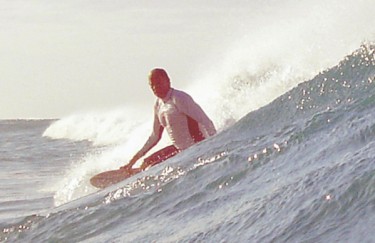
Photo by Ken Patton.
13.
Do you see many paipo being ridden in Hawai`i? Who are some of the
standouts? Where would you see paipo riders these days?
I
only ride a few spots these days, mostly Publics. The people I see are
there or over at the next break called “Cunha’s.” Cunha’s only breaks
when it’s over six feet or so. And the Wall at Kapahulu. As for the
entire island of Oahu… Makaha, Makapu`u, Laniakea. Some of the stand
outs are Harry Akisada and his nephew Mike, John Clark, Kimo Kealoha,
Nate, and Big Ed. The sad thing is, I’m horrible with names.
14.
Any surfs or waves still stand out for you?
The
best wave is the one you remember while driving away from the session,
but my spot currently is Publics. I’ve had a few injuries requiring
stiches from that reef and some serious board damage, but overall it’s
worth it. The reef at Publics is both gnarly and exciting. I love
Makapu`u when it’s over six feet and breaking in the middle of the bay,
and Laniakea over six feet. I wish the Pipeline wasn’t so choked with
all sorts of people or I’d go there again. Off the Wall is good when
the swell is from the right direction.
Riding Makapu'u on a smaller day, January 2009.
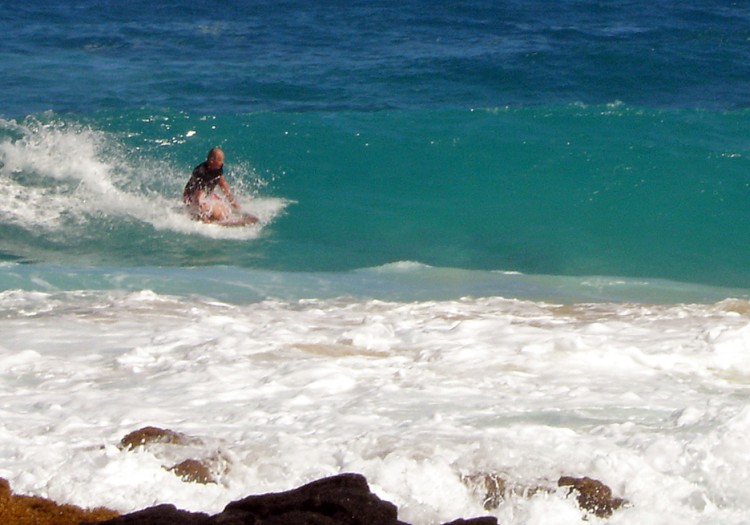
Photo by Leilani Logan.
15.
What is the attraction for you of riding paipo?
One
is the ability of being able to ride reefy locations. Another is the
high speed. I will pass anything out there on a big day. There is a big
advantage in being able to duck dive any size wave with ease, never
getting pushed back. On crowded days I have even ridden over the tail
of a surfboard or two when they insist on sitting on the inside at the
bottom of the break. On the rare occasion of somehow loosing the board,
it will only go 10 to 20 feet inside, so it’s easy to recover. There
are also some mundane advantages: I can make my own boards, and there’s
always a board in my car so I can adapt to a change of work schedule
and get in the water.
16.
Any other comments?
My
fins used to be the big brown UDT Duck Feet. They were very stiff. I
used to have to swim laps in Newport Harbor to keep in good enough
shape to use them effectively since the take off at the Wedge required
a short strong back stroke or even an underwater take off. They stopped
making those fins, although I see them on eBay now and again. What I
now use are a pair of modified blue Duck Feet. I sewed some neoprene to
the straps to help keep them on, and I wear full neoprene booties to
not just protect my toes but to also protect my heels. I got a 3 inch
gash in my heel when I finished a wave on a moderate day at Publics and
the following wave threw me back-first onto the coral head I had been
treading water next to. That injury needed a lot of stiches. The other
way I’ve modified my fins is that I totally sanded off the ridges on
both the top and bottom sides of the fins. You can barely see the word
Duck Feet.
Regular and modified Duck Feet swim fins
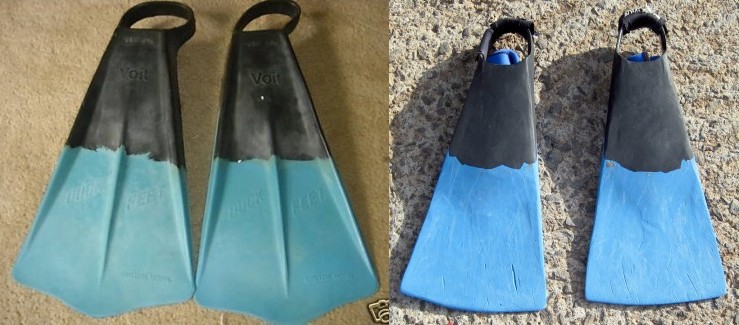
Click above image for a larger view and click here for a larger image of Bud's modified fins.
Photos courtesy of eBay advertisement and Bud Scelsa.
That shape really has helped when knee riding as the fins
lay very flat on the board and do not tend to move or slide around. The
alterations also reduced some weight as the newer Duck Feet use a
different, denser rubber which is not as flexible. I love the fin
system I’m using now. I have seen no fin design, at any price, that
would convince me to change. The only real drawback is I am unable to
get the tips of the fins around when I try to stand up. I’m still
working on how to do it.
|
Addendum:
- Paipo board construction of a mostly old fir board for Dukie Duvauchelle - click here.
- An article about Bud Scelsa: Pendarvis, Cher. (2013, October). Captain Bud Scelsa: an inspiration across generations and cultures. legless.tv. Accessed on October 14, 2013, at legless.tv/.
RIP Bud Scelsa

|
|
|
